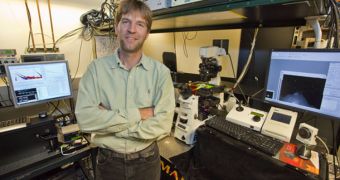A group of investigators at the US Department of Energy's (DOE) Lawrence Berkeley National Laboratory (Berkeley Lab) announces the development of a new cellular patterning method, which enables researchers to reach an unprecedented degree of accuracy in spatial pattern studies.
Scientists determined some time ago that the distance between cells can mean the difference between life or death, or between a cell remaining healthy or turning cancerous. As such, understanding the influence of inter-cellular distance on these systems is essential.
Studying the impact of spatial patterns on living cells has been a direction of research in molecular biology for quite some time, but techniques used to conduct such work did not have the necessary resolution to enable in-depth studies.
In the new experiments, the Berkeley Lab team managed to create lipid molecule-based fluid bilayers embedded with fixed arrays of gold nanoparticles. This enabled the team to control the spacing of proteins and other similar molecules located inside this construct.
Chemist Jay Groves, the leader f the experiments, says that the level of resolution this study technique provides is unprecedented. “The gold nanoparticles are similar to the size of a single protein molecule, which gets us to a scale we couldn’t really access before,” he says.
“As the first example of a biological membrane platform that combines fixed nanopatterning with the mobility of fluid lipid bilayers, our technique represents an important improvement over previous patterning methods,” the investigator explains.
Details of the new investigation were published in a paper called “Supported Membranes Embedded with Fixed Arrays of Gold Nanoparticles,” which appears in the latest issue of the esteemed scientific journal Nano Letters. Groves was the corresponding author of the research.
The expert holds joint appointments with Berkeley Lab Physical Biosciences Division (PBD) and the University of California in Berkeley (UCB) Chemistry Department. He is also a Howard Hughes Medical Institute (HHMI) investigator.
“Immobile patterning intrinsically defeats any cellular process that naturally involves movement. On the other hand we need to be able to impose some fixed barriers in order to manipulate membranes in really novel ways,” he concludes.

 14 DAY TRIAL //
14 DAY TRIAL //